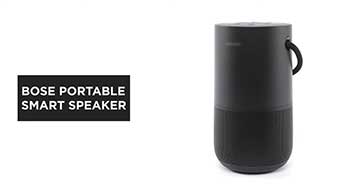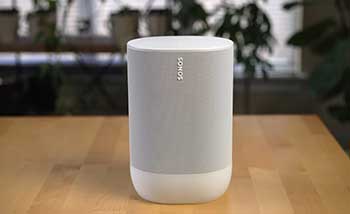Portable speakers are a great way to take your music with you wherever you go. Two of the top players in the portable Bluetooth speaker market are Bose and Sonos. Bose has the Portable Smart Speaker while Sonos offers the Move. But which one is better?
In this comprehensive guide, we’ll compare the Bose Portable Smart Speaker and Sonos Move on key factors like sound quality, smart features, battery life and more. By the end, you’ll have all the details you need to decide which portable speaker best fits your needs and budget.
A Brief Comparison Table
| Feature | Bose Portable Smart Speaker | Sonos Move |
| Sound Quality | Very good, balanced sound with punchy bass | Excellent audio with deep bass, can sound boomy at high volumes |
| Smart Features | Amazon Alexa and Google Assistant built-in, WiFi and Bluetooth connectivity | Amazon Alexa built-in, WiFi only connectivity, connects to other Sonos speakers |
| Battery Life | Up to 12 hours | Up to 10 hours |
| Durability | IPX4 splash resistance | IP56 dust and moisture resistance |
| Voice Control | 6-mic array for better Alexa pickup | Single microphone for Alexa |
| Setup | Quick and easy with Bose Connect app | More tedious, requires Sonos app and account |
| Price | $399 | $399 |
Sound Quality
First and foremost, a portable speaker needs to sound good. Crisp treble, full midrange and rich bass are musts for an immersive listening experience. So how do Bose and Sonos stack up?

The Bose Portable Smart Speaker features proprietary Bose technology to deliver surprisingly big 360-degree sound for its compact size. Reviewers praise its well-balanced audio with punchy bass you can feel, clear vocals and crisp highs. It can easily fill a room with rich, detailed sound you wouldn’t expect from such a portable unit.
On the other hand, the Sonos Move also produces impressive room-filling sound thanks to a downward-firing tweeter and mid-woofer. It delivers deep bass, natural sounding mids and clear highs. The sound is perfectly tuned to the speaker’s shape to eliminate distortions. However, some critics say the bass can be overly boomy at high volumes.
Both portable speakers can get plenty loud to power a small party. But audiophiles give a slight edge to the Bose for more accurate audio reproduction across the frequency spectrum.
Smart Features
Modern portable speakers need to be more than just great sounding. Connectivity and smart features are also key. How intelligent are the Bose and Sonos models?
The Bose Portable Smart Speaker lives up to its name with built-in voice assistants. You get access to Amazon Alexa and Google Assistant for hands-free voice control. Use voice commands to play music, get information, set reminders and more. Connect via Wi-Fi or Bluetooth to stream from services like Spotify, Apple Music and Pandora.

Meanwhile, the Sonos Move has Amazon Alexa and works with over 100 streaming services. Connect via Wi-Fi at home and switch to Bluetooth when on the go. Use the Sonos app for easy setup, multi-room audio and stereo pairing. Tap the mic button to activate Alexa for voice commands.
Both speakers give you excellent flexibility and smart features. However, only the Move can connect directly to other Sonos speakers for whole-home audio. The Bose currently lacks multi-room support.
Battery Life
Portable speakers need sufficient battery life for enjoyment on the go. Short battery life hampers the listening experience when outdoors or traveling.
The Bose Portable Smart Speaker offers an advertised battery life of up to 12 hours. In real-world testing, many users report getting 10-11 hours at moderate volumes – still very good. The battery charges in just over 3 hours.
Comparatively, Sonos promises up to 10 hours of continuous playtime on the Move. In practice, users find they get 8-9 hours before needing to recharge. A full charge takes about 2.5 hours.
For battery performance, both speakers deliver as advertised. The Bose ekes out a win with slightly longer playtimes, but the Sonos still provides all-day listening off a single charge.
Durability & Portability
Since portable speakers get taken everywhere, they need to withstand bumps, drops, dust, moisture and more. Durability is a must. Additionally, a portable form factor makes them easy to travel with.
Ruggedness is a high point for the Sonos Move. It boasts an incredibly durable design rated IP56 for dust, dirt and moisture resistance. Drop it, get caught in the rain, take it to the beach – the Move won’t mind at all. At 3 lbs, it’s hefty but still perfectly portable.
The Bose Portable Smart Speaker has an IPX4 splash resistant rating. It can handle splashes and sprays with no problem. But it’s not fully dust or waterproof like the Move. The Bose weighs 2.3 lbs, slightly lighter and easier to carry around. Still, the Sonos is the winner for durability.
Also Read: Comparison Between JBL Clip 4 And Flip 5.
Voice Control
Both speakers offer built-in voice control via Alexa, but how do their voice assistant implementations compare?
The Bose Portable Smart Speaker has a dedicated Action button to activate Alexa. The six-microphone array ensures accurate voice pick-up from across the room. Alexa responses come through nice and clear from the speaker. You get full access to Amazon’s assistant for music, information, smart home control and more.
On the other hand, the Sonos Move only has a single far-field microphone for Alexa. This makes voice pick-up less consistent, especially at a distance or in noisy environments. However, Alexa’s responses are loud and clear thanks to Sonos’ excellent sound. You get the same Alexa capabilities as the Bose.
For better microphone performance, the Bose Portable Smart Speaker pulls ahead. Alexa is easier to activate from anywhere in the room. But both speakers offer similarly useful Alexa integration overall.
Ease Of Setup
Wireless speakers should be simple and intuitive to set up. Complicated setup processes are frustrating for users. How easy is it to get started on Bose and Sonos?
Setting up the Bose Portable Smart Speaker is quick and painless. Download the Bose Connect app, connect to Wi-Fi and you’re ready for streaming in minutes. The step-by-step process is straightforward with clear instructions. Connecting via Bluetooth is also easy.
The Sonos Move needs to be added to your Sonos system in the Sonos app. If you don’t have Sonos already, this requires creating a Sonos account first. The Move only connects via Wi-Fi – no Bluetooth option. The multi-step setup can be a bit tedious compared to the Bose.
Overall, the Bose Portable Smart Speaker offers simpler, more user-friendly setup right out of the box. It’s ready to use in just a few taps whether on Wi-Fi or Bluetooth. The Sonos Move requires a lengthier initial configuration.
Also watch the video!
Price
With premium sound and features comes premium pricing. How much does it cost to own these high-end portable speakers?
The Bose Portable Smart Speaker retails for $399. This positions it as an upper mid-range portable speaker. While not cheap, you get excellent Bose sound quality and smarts for the price.
In comparison, the Sonos Move carries a higher $399 price tag. As Sonos’ most advanced (and only) portable speaker, it sits at the upper end of the market. Given its premium construction and audio, the price can be justified.
For shoppers on a tighter budget, the $100 savings of the Bose Portable Smart Speaker makes it a bit more wallet-friendly. But the Sonos Move wins for those wanting the very best sound and durability.
Also Read: Comparison Between JBL Xtreme 2 And Xtreme 3.
Frequently Asked Questions (FAQ)
For pure audio quality, Bose portable speakers like the Portable Smart Speaker tend to edge out Sonos. Bose sound is more natural, balanced and accurate while still delivering deep bass.
However, Sonos portable speakers like the Move have excellent durability and smart home integration that Bose can lack. Overall Bose may sound better, but Sonos offers greater versatility.
Overall Bose speakers tend to produce superior sound quality compared to Sonos based on audio tests. Bose focuses on achieving a very natural, balanced sound profile with rich details. But Sonos speakers still sound great with good bass, crisp treble and clear vocals. Sonos’ advantage is its whole-home audio system – Bose speakers can’t integrate into a Sonos network.
The Bose Home Speaker 500 will sound better than the Sonos Move with a more open, room-filling soundstage. However, the Sonos Move is built tougher with dust/waterproofing and offers finer smart controls through the Sonos app. The Home Speaker 500 only has Alexa built-in. So for better sound at home, choose the Bose. But for an ultra-durable portable Sonos speaker, the Move is hard to beat.
Bang & Olufsen, Sennheiser and Klipsch speakers can produce audio quality on par or slightly better than Bose based on expert reviews. These high-end brands focus heavily on engineering top notch sound.
However, they are also significantly more expensive than Bose speakers. For more affordable options that still beat Bose for sound, try speakers from Audioengine, Kanto or Presonus.
Also Read: Is JBL Charge 5 Better Than Bose Soundlink Flex?
The Verdict
So, which portable speaker comes out on top – the Bose Portable Smart Speaker or Sonos Move?
For pure sound quality, the Bose edges out the Sonos with richer, more balanced audio and deeper bass. It’s also $100 cheaper and easier to set up right out of the box. The Bose excels at home, coupled with great smart features thanks to Alexa built-in.
However, the Sonos Move pulls ahead for those who want a durable, take-anywhere speaker. Its rugged design can withstand anything life throws at it. Sonos’ excellent sound, Alexa support and multi-room audio also give it flexibility. But you’ll pay a premium for its top-of-the-line features.
Overall, the Bose Portable Smart Speaker wins as the best portable Bluetooth speaker combining great sound, smart features and fair pricing. But serious Sonos fans who want that trademark audio in a super durable package will love the Move.
Either way, you can’t go wrong with these stellar portable speakers from audio giants Bose and Sonos!
